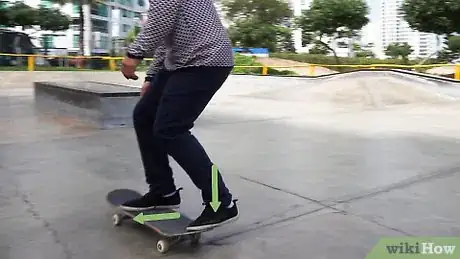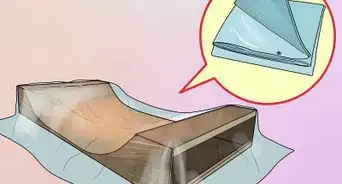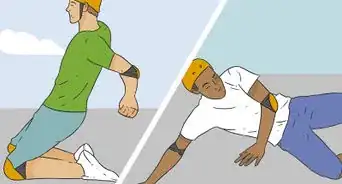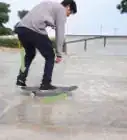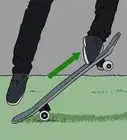This article was co-authored by wikiHow Staff. Our trained team of editors and researchers validate articles for accuracy and comprehensiveness. wikiHow's Content Management Team carefully monitors the work from our editorial staff to ensure that each article is backed by trusted research and meets our high quality standards.
The wikiHow Video Team also followed the article's instructions and verified that they work.
This article has been viewed 25,218 times.
Learn more...
A noseslide is a skateboarding trick in which you slide on a rail (or curb) on the nose edge (the front end) of your skateboard. You'll need to know a few other fundamental tricks before you're able to master a noseslide, including an ollie, kickturn, and frontside 180s. The key to this trick is learning to balance on the nose end of your skateboard, so be patient with yourself while you're learning how to noseslide.
Steps
Doing a Noseslide
-
1Position your feet properly. Your feet should start in ollie position; back foot near the tail end of your board and front foot around the front wheels. As you noseslide, your feet will move forward about 2 inches as you shift your weight from the back of the board to the front. Imagine jumping and landing with your front foot on the edge of the object you are grinding.
-
2Skate towards a low curb or rail (about 4 inches off the ground). You should use a medium amount of speed as you approach the curb or rail. Your skateboard should be parallel to the curb or rail. Once you're next to the rail/curb, make sure your board is roughly 5 inches away from it, and then do an ollie into your noseslide.Advertisement
-
3Do an ollie to lift the front of the board just enough to get onto the curb. As you ollie, slide your feet toward the front of your board to shift your weight from back foot to front foot. All of your weight should be on your front foot, which should now be on the nose of your board. You should have no weight on your back foot and your back foot should be placed on the back screws of your skateboard.
- Now you must swing your skateboard so that it rides perpendicular on the curb or rail (like a T shape). To do this, rotate 90-degrees once the nose of your board is off the ground. Then land the nose of your board along the rail or curb and start to slide slide.[1]
-
4Slide the nose of your board along the curb or rail. You should use your momentum to slide until you either reach the end of the rail/curb or run out of speed. Your board will not stay on the rail/curb if you put any weight on your back foot, so be sure to keep all of your weight on your front foot. Start this trick by practicing short distances to get familiar with balancing your skateboard during a noseslide.
-
5Dismount the rail/curb with a kickturn. You'll do this by shifting your weight back to the tail end of the board and swinging the nose of your board 90-degrees so that it's once again perpendicular to the curb or rail. Then you'll bring your wheels back down.
- To shift the weight back to the tail end of your board, move your front foot back about 2 inches and shift some of your body weight to your back foot.[2]
Mastering Other Moves
-
1Learn how to do an ollie and a kickturn before attempting to do a noseslide. You will use elements from these tricks in your noseslide, so it is important that you're familiar with them.
- An ollie is the most fundamental skateboarding trick there is, as it's a part of many other tricks. It is usually used to start tricks, as it's basically a jump that gets the skateboard off of the ground. Doing an ollie is necessary in a noseslide, so be sure to learn it.
- A kickturn is a basic skateboarding skill, and you'll use it to end your noseslide. Kickturning is when you balance on the tail end of your board for a moment and swing the front of your board to a new direction. Kickturning is typically used to end tricks and turn your board.[3]
-
2Learn how to do a few other skateboarding tricks first. Though it's not absolutely necessary, it's recommended to learn a frontside 180 and a boardslide before a noseslide. Learning these tricks will teach you some skills that will make performing a noseslide a bit easier. However, it is possible to do a noseslide without learning these tricks first.[4]
-
3Practice doing a nose stall first. A nose stall is very similar to a noseslide, so being comfortable with a nose stall will make doing a noseslide much easier. A nose slide will teach you how to shift your weight between your back and front foot, a very crucial part of both tricks. Once you've mastered this, you can move on to a noseslide.
- A nose stall is basically a noseslide without the slide. Practice by skating up to a low curb or rail and doing an ollie to land the nose of your board onto the curb or rail. This will get comfortable balancing your weight on your front foot and on the nose of your board.[5]
-
4Work on your balance. When doing a noseslide, you must balance all of your weight on the nose of your board for it to be successful. You need to get comfortable with shifting your weight from the tail of the board onto the nose of the board, and vice verse. You can work on your balance by practicing nose stalls, as they require a shift of balance between the tail and nose of your board.[6]
Things You'll Need
- Skateboard (You'll definitely need a skateboard. The rest of these are optional but recommended)
- Helmet
- Wrist guards
References
- ↑ http://riders.co/en/skate/grinds/fs-noseslide/
- ↑ http://www.skateboardhere.com/noseslide.html
- ↑ http://www.skateboardhere.com/kickturn.html
- ↑ http://www.skateboardhere.com/noseslide.html
- ↑ http://riders.co/en/skate/ramp/nosestall/
- ↑ http://skateboard.about.com/od/streetskateboardingtricks/ss/Nose_Stall.htm
- https://www.youtube.com/watch?v=IyGtjrwPi-0
